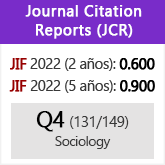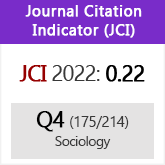El papel del locus de control del jefe entre el guanxi percibido y la conducta de liderazgo en los negocios familiares
DOI:
https://doi.org/10.3989/ris.2013.08.11Palabras clave:
Bases del poder, Guanxi percibido, Locus de control, Tácticas de influenciaResumen
La histórica y especial red de relaciones de la sociedad china se basa en lazos de sangre o en conexiones familiares emocionales de las que los negocios familiares son la mejor representación. Junto con la especialización de las estructuras corporativas, la cuestión clave de esta investigación será el poder y el liderazgo de los jefes sobre los subordinados, poniendo el énfasis en la personalidad del jefe. En el modelo de investigación –administración de un cuestionario a 147 negocios familiares de Taiwán, de los que 332 fueron válidos- combinamos el “guanxi” de las sociedades chinas, el poder, las tácticas para tener influencia y el locus de control. Mediante análisis jerárquicos de regresión los resultados muestran la estrecha relación que se da entre el poder de los jefes, el “guanxi” percibido y la conducta de liderazgo, en la que el locusde control de los jefes desempeña un papel destacado. Por eso se recomienda que la designación de jefes en esas empresas sea más cuidadosa. Además de la comunicación con los subordinados, debe prestarse atención a la adecuación entre personalidad y la competencia para mantener una eficiencia laboral y unas relaciones entre jefes y subordinados favorables.
Descargas
Citas
Arregle, J., Hitt, M. A., Sirmon, D. G. and Very, P. 2007. "The development of organizational social capital: Attributes of family firms." Journal of Management Studies 44(1):73-95. http://dx.doi.org/10.1111/j.1467-6486.2007.00665.x
Baron, R. M. and Kenny, D. A. 1986. "The moderator-mediator variables distinction in social psychological research: Conceptual, strategic, and statistical considerations." Journal of Personality and Social Psychology 51(6):1173-1182. http://dx.doi.org/10.1037/0022-3514.51.6.1173 PMid:3806354
Bernardi, R. A. 2011. "The relationships among locus of control, perceptions of stress and performance." Journal of Applied Business Research 13(4):1-8.
Boone, C. and Hendriks, W. 2009. "Top management team diversity and firm performance: Moderators of functional-background and locus-of-control diversity." Management Science 55(2):165-180. http://dx.doi.org/10.1287/mnsc.1080.0899
Brass, D. J. and Burkhardt, M. E. 1993. "Potential Power and Power Use: An Investigation of Structure and Behavior." Academy of Management Journal 36:441-470. http://dx.doi.org/10.2307/256588
Brisset, M., and Nowicki, S. 1973. "Internal versus external control of reinforcement and reaction to frustration." Journal of personality and social psychology 25(1): 35-44. http://dx.doi.org/10.1037/h0034247
China Credit Information Service, 2010. "Top 10 largest business groups for 2010, showing that the financial industry almost taking all away while the technology industry is giving all up!" http://news.cnyes.com/Content/20101027/KCCBQBM8AQETQ.shtml.
Chung, H. M. 2012. "The role of family management and family ownership in diversification: The case of family business groups." Asia Pacific Journal of Management, doi:10.1007/s10490-012-9284-x. http://dx.doi.org/10.1007/s10490-012-9284-x
Conger, J. A. and Kanungo, R. N. 1987. "Toward a behavioral theory of charismatic leadership in organizational settings." Academy of Management Review 12:637-647.
David, V. D. and Stanley, B. S. 1989. "Personality and job performance: Evidence of incremental validity." Personnel Psychology 42:25-36. http://dx.doi.org/10.1111/j.1744-6570.1989.tb01549.x
Durbin, A. J. 2001. Leadership: research findings, practice and skills (3rd ed.). Houghton Mifflin Company.
Finkelstein, S. 1992. "Power in top management teams: Dimensions, measurement, and validation." Academy of Management Journal 35:505-538. http://dx.doi.org/10.2307/256485
Furnham, A. and Drakeley, R. J. 1993. "Work locus of control and perceived organizational climate." The European Work and Organizational Psychologist 3(1):1-9.
French, J. R. P. and Raven, B. 1959. The bases of social power. D.Cartwright, Studies in Social Power (ed.). Institute for Social Research, Ann Arbor, MI.
Gold, T., Guthries, D. and Wank, D. 2002. Social Connections in China. Cambridge: Cambridge University Press. http://dx.doi.org/10.1017/CBO9780511499579
Haybatollahi, M. and Gyekye, S. A. 2012. "The moderating effects of locus of control and job level on the relationship between workload and coping behavior among Finnish nurses." Journal of Nursing Management. doi: 10.1111/j.1365-2834.2012.01474.x http://dx.doi.org/10.1111/j.1365-2834.2012.01474.x
Hinkin, T. R. and Schriesheim, C. A. 1989. "Development and Application of New Development and Application of New Scales to Measure the French and Raven (1959) Bases of Social Power." Journal of Applied Psychology 74:561-567. http://dx.doi.org/10.1037/0021-9010.74.4.561
Holpp, L. 1994. "Applied empowerment." Training 31(2):39-44.
Hwang, K. K. 1987. "Face and favor: the Chinese power game." American Journal of Sociology 92:944-974. http://dx.doi.org/10.1086/228588
Jacobs, J. B. 1979. "A preliminary model of particularistic ties in Chinese political alliances: Kan-ch'ing and Kuan-hsi in a rural Taiwanese township." The China Quarterly 78:237-273. http://dx.doi.org/10.1017/S0305741000040467
Judge, T. A. and Bono, J. E. 2001. "Relationship of core self-evaluation traits-self-esteems, generalized self-efficacy, locus of control, and emotional stability-with job satisfaction and job performance: A meta analysis." Journal of Applied Psychology 86(1):80-92. http://dx.doi.org/10.1037/0021-9010.86.1.80 PMid:11302235
Kellermanns, F. W. and Eddleston, K.A. 2004. "Feuding families: When conflict does a family firm good." Entrepreneurship Theory and Practice 28(3):209-228. http://dx.doi.org/10.1111/j.1540-6520.2004.00040.x
Kipnis, D., Schmidt, S. M. and Wilkinson, I. 1980. "Intraorganizational influence tactics: explorations in getting one's way." Journal of Applied Psychology 65(4):440-452. http://dx.doi.org/10.1037/0021-9010.65.4.440
Lee, D. J., Pae, J. H. and Wong, Y. H. 2001. "A model of close business relationships in China (guanxi)." European Journal of Marketing 35(1/2):51-69. http://dx.doi.org/10.1108/03090560110363346
Lee, D. Y. and Dawes, P. L. 2005. "Guanxi, trust, and long-term orientation in Chinese business markets." Journal of International Marketing 13(2):28-43. http://dx.doi.org/10.1509/jimk.13.2.28.64860
Martin, R., Thomas, G., Charles, K., Epitropaki, O. and McNamara, R. 2005. "The role of leader-member exchanges in mediating the relationship between locus of control and work reactions." Journal of Occupational and Organizational Psychology 78:141-147. http://dx.doi.org/10.1348/096317904X23763
May, D. R., Gilson, R. L. and Harter, L. M. 2004. "The psychological conditions of meaningfulness, safety and availability and the engagement of the human spirit at work." Journal of Occupational and Organizational Psychology 77(1):11-37. http://dx.doi.org/10.1348/096317904322915892
Meyer, J. P., Stanley, D. J., Herscovitch, L. and Topolnytsky, L. 2002. "Affective, continuance, and normative commitment to the organization: A meta-analysis of antecedents, correlates, and consequences." Journal of vocational behavior 61(1):20-52. http://dx.doi.org/10.1006/jvbe.2001.1842
Miller, D. and Le Breton-Miller, I. 2006. "Family governance and firm performance: Agency, stewardship, and capabilities." Family Business Review 19(1):73-87. http://dx.doi.org/10.1111/j.1741-6248.2006.00063.x
Ng, T. W. and Feldman, D. C. 2011. "Locus of control and organizational embeddedness." Journal of Occupational and Organizational Psychology 84(1):173-190. http://dx.doi.org/10.1348/096317910X494197
O'Reilly, C. A. 1977. "Personality-job fit: Implications for individual attitudes and performance." Organizational Behavior and Human Performance 18(1):36-46. http://dx.doi.org/10.1016/0030-5073(77)90017-4
Pierce, L.W. and Dunham, R.B. 1987. "Organizational commitment: Pre-employment propensity and initial work experiences." Journal of Management 13(1):163-178. http://dx.doi.org/10.1177/014920638701300113
Podsakoff, P. M., MacKenzie, S. B., Lee, J. Y. and Podsakoff, N. P. 2003. "Common method biases in behavioral research: A critical review of the literature and recommended remedies." Journal of Applied Psychology 88(5):879-903. http://dx.doi.org/10.1037/0021-9010.88.5.879 PMid:14516251
Robbins, S. P. 2001. Organizational Behavior (9th ed.). New Jersey: Prentice-Hall.
Rosenberg, M. and Pearlin, L. 1962. "Power-orientations in the mental hospital." Human Relations 15:335-349. http://dx.doi.org/10.1177/001872676201500403
Rotter, J. B. 1954. Social learning and clinical psychology. Englewood cliffs, NJ: Prentice-Hall. http://dx.doi.org/10.1037/10788-000
Rotter, J. B. 1966. "Generalized expectancies for internal versus external control of reinforcement." Psychological Monographs: General and Applied 80(1):1-27. http://dx.doi.org/10.1037/h0092976 PMid:5340840
Schriesheim, C. A. and Hinkin, T. R. 1990. "Influence tactics used by subordinates: a theoretical and empirical analysis and refinement of the Kipnis, Schmidt, and Wilkinson subscales." Journal of Applied Psychology 75(3):246-257. http://dx.doi.org/10.1037/0021-9010.75.3.246
Spector, P. E. 1982. "Behavior in organizations as a function of employee's locus of control." Psychological bulletin 91(3):482-497. http://dx.doi.org/10.1037/0033-2909.91.3.482
Spector, P. E. 1988. "Development of the work locus of control scale." Journal of occupational psychology 61(4):335-340. http://dx.doi.org/10.1111/j.2044-8325.1988.tb00470.x
Taormina, R. J. and Gao, J. H. 2010. "A research model for Guanxi behavior: Antecedents, measures, and outcomes of Chinese social networking." Social Science Research 39(6):1195-1212. http://dx.doi.org/10.1016/j.ssresearch.2010.07.003
Tsai, H. T., Yeh, S. P. and Wu, T. J. 2011. "The use of governmental-firm guanxi under different market conditions for Taiwanese hospitality firms invested in China." Actual Problems of Economics 12(2):4-11.
Tsai, H. T., Wu, T. J. and Yeh, S. P. 2013. "Exploring the guanxi type of managers in family businesses from the perspective of power based and leadership behaviors." South African Journal of Economic and Management Sciences. (Forcecoming)
Yang, C. F. 2000. Psychocultural foundations of informal groups: The issues of loyalty, sincerity, and trust. In L. Dittmer, H. F. and Lee, P.N.S. (Eds.), Informal Politics in East Asia (pp 85-105). NY: Cambridge University Press.
Yang, M. M. 1994. Gifts, favors and banquets: The art of social relationships in China. NY: Cornell University Press.
Yukl, G. 2002. Leadership in Organizations (4th ed.). NJ: Prentice Hall. PMid:11820775
Yukl, G. and Falbe, C. M. 1990. "Influence tactics in upward, downward, and lateral influence attempts." Journal of Applied Psychology 75:132-140. http://dx.doi.org/10.1037/0021-9010.75.2.132
Zhang, X. and Li, G. 2003. "Does guanxi matter to nonfarm employment?" Journal of Comparative Economics 31(2):315-331. http://dx.doi.org/10.1016/S0147-5967(03)00019-2
Zhuang, G., Xi, Y. and Tsang, S. L. 2010. "Power, conflict, and cooperation: The impact of guanxi in Chinese marketing channels." Industrial Marketing Management 39:137-149. http://dx.doi.org/10.1016/j.indmarman.2008.07.002
Descargas
Publicado
Cómo citar
Número
Sección
Licencia
Derechos de autor 2014 Consejo Superior de Investigaciones Científicas (CSIC)

Esta obra está bajo una licencia internacional Creative Commons Atribución 4.0.
© CSIC. Los originales publicados en las ediciones impresa y electrónica de esta Revista son propiedad del Consejo Superior de Investigaciones Científicas, siendo necesario citar la procedencia en cualquier reproducción parcial o total.Salvo indicación contraria, todos los contenidos de la edición electrónica se distribuyen bajo una licencia de uso y distribución “Creative Commons Reconocimiento 4.0 Internacional ” (CC BY 4.0). Puede consultar desde aquí la versión informativa y el texto legal de la licencia. Esta circunstancia ha de hacerse constar expresamente de esta forma cuando sea necesario.
No se autoriza el depósito en repositorios, páginas web personales o similares de cualquier otra versión distinta a la publicada por el editor.

















